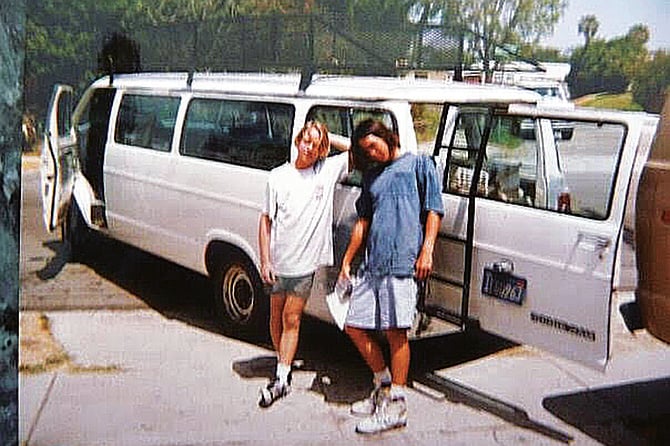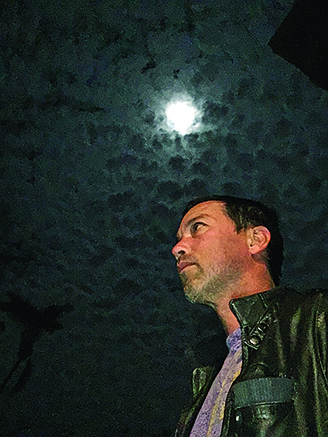 Facebook
Facebook
 X
X
 Instagram
Instagram
 TikTok
TikTok
 Youtube
Youtube

Abe DeLeon delivered the San Diego Reader from 1986 until January of this year. At one point or another, he handled almost every route the paper offered: from Oceanside to Imperial Beach, and as far east as Alpine. He was maybe 15 when he started helping on his dad’s North County route; he stopped because he and his wife, an architect, want to buy land and build a house. (They wound up in affordable Asheville, North Carolina.) In the B.C. (Before Craigslist) era, he recalls, “Having the freedom to drive around the city and hand out the most popular paper in town was a dream job. Everyone advertised in the Reader, and every store wanted it. If they were advertisers, they automatically got it; otherwise, if a place couldn’t move 20 copies, we didn’t bother with them. Employees and customers were happy to see me, and I can’t tell you how many times I heard, ‘Hot off the press!’”
“Dream job” should not, however, be confused with “easy job.” “Distribution was really massive. A guy named Dave Hicks laid out the stops; one route would have 100-150 stops.” For drivers like DeLeon who took on multiple routes, “it was a 28-hour shift. I would start on Wednesday afternoon and get done Thursday evening, with maybe two hours of sleep along the way. I’d go up to San Dieguito printers in La Costa and put two tons of papers in my one-ton Ford Econoline 350 van.” (Work was subcontracted, so drivers brought their own rides.) “First route was UCSD; I was able to drive all over campus. That route had only a few stops, but every stop got 25 bundles, and there were 20 papers in a bundle, and the Reader was 220 pages in those days, really big. When I was around 20 years old, I started using my skateboard to transfer the bundles. I liked it better than a dolly, because I could stack three rows, five bundles high.

“After that, I drove downtown and filled the plastic Reader boxes on the street corners. Then I delivered to the 7-11s and everywhere else that was open 24 hours. The 7-11s were the hot spots, together with the grocery stores and the VA hospital. Then I’d go back to La Costa around 4 am to get my next load. I always said that the reason I never had to go to the gym was that I delivered the Reader. At one point, I counted how many pounds I picked up in a 24-hour period between loading and unloading, and it was something like 30,000. By Thursday night, you needed about 20 hours to recover. But I made enough money — about $25 an hour — to not have to work the rest of the week. I could do fun things. My main passions were music and surfing; during daylight savings, I planned my route so I could end at the beach and surf. I’d say more than 75% of Reader drivers made enough money to survive on.”
In the days A.D. (After Digital), of course, all that changed for the smaller. And no doubt Generation iPhone sees thousands of pounds of newsprint needing hauling around every week as a bug and not a feature. But it gave DeLeon a job that took him all over the city and also revealed it to him, and he holds that “You’re not a San Diegan if you’ve never read the Reader. I read almost every issue: mostly the music section and Matthew Alice” — our unstumpable local search engine in the days before Google — “and sometimes the cover story. I would get excited to see my favorite bands listed for upcoming shows, and I got super excited when my own band, Recordable Colors, got a spotlight.” And there were those classifieds. “Everyone used them, for everything from finding a house to finding a mate.”
“I will miss San Diego,” concludes DeLeon, who plans to continue the family tradition of furniture upholstery out east. “I would like to give a shout-out to all former and present Reader drivers, and Dave Hicks, and my mom and dad.”


Abe DeLeon delivered the San Diego Reader from 1986 until January of this year. At one point or another, he handled almost every route the paper offered: from Oceanside to Imperial Beach, and as far east as Alpine. He was maybe 15 when he started helping on his dad’s North County route; he stopped because he and his wife, an architect, want to buy land and build a house. (They wound up in affordable Asheville, North Carolina.) In the B.C. (Before Craigslist) era, he recalls, “Having the freedom to drive around the city and hand out the most popular paper in town was a dream job. Everyone advertised in the Reader, and every store wanted it. If they were advertisers, they automatically got it; otherwise, if a place couldn’t move 20 copies, we didn’t bother with them. Employees and customers were happy to see me, and I can’t tell you how many times I heard, ‘Hot off the press!’”
“Dream job” should not, however, be confused with “easy job.” “Distribution was really massive. A guy named Dave Hicks laid out the stops; one route would have 100-150 stops.” For drivers like DeLeon who took on multiple routes, “it was a 28-hour shift. I would start on Wednesday afternoon and get done Thursday evening, with maybe two hours of sleep along the way. I’d go up to San Dieguito printers in La Costa and put two tons of papers in my one-ton Ford Econoline 350 van.” (Work was subcontracted, so drivers brought their own rides.) “First route was UCSD; I was able to drive all over campus. That route had only a few stops, but every stop got 25 bundles, and there were 20 papers in a bundle, and the Reader was 220 pages in those days, really big. When I was around 20 years old, I started using my skateboard to transfer the bundles. I liked it better than a dolly, because I could stack three rows, five bundles high.

“After that, I drove downtown and filled the plastic Reader boxes on the street corners. Then I delivered to the 7-11s and everywhere else that was open 24 hours. The 7-11s were the hot spots, together with the grocery stores and the VA hospital. Then I’d go back to La Costa around 4 am to get my next load. I always said that the reason I never had to go to the gym was that I delivered the Reader. At one point, I counted how many pounds I picked up in a 24-hour period between loading and unloading, and it was something like 30,000. By Thursday night, you needed about 20 hours to recover. But I made enough money — about $25 an hour — to not have to work the rest of the week. I could do fun things. My main passions were music and surfing; during daylight savings, I planned my route so I could end at the beach and surf. I’d say more than 75% of Reader drivers made enough money to survive on.”
In the days A.D. (After Digital), of course, all that changed for the smaller. And no doubt Generation iPhone sees thousands of pounds of newsprint needing hauling around every week as a bug and not a feature. But it gave DeLeon a job that took him all over the city and also revealed it to him, and he holds that “You’re not a San Diegan if you’ve never read the Reader. I read almost every issue: mostly the music section and Matthew Alice” — our unstumpable local search engine in the days before Google — “and sometimes the cover story. I would get excited to see my favorite bands listed for upcoming shows, and I got super excited when my own band, Recordable Colors, got a spotlight.” And there were those classifieds. “Everyone used them, for everything from finding a house to finding a mate.”
“I will miss San Diego,” concludes DeLeon, who plans to continue the family tradition of furniture upholstery out east. “I would like to give a shout-out to all former and present Reader drivers, and Dave Hicks, and my mom and dad.”
Comments